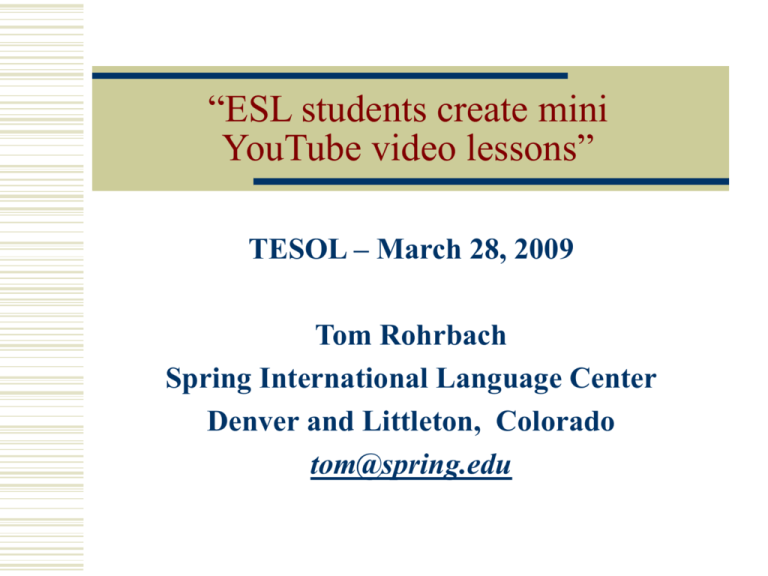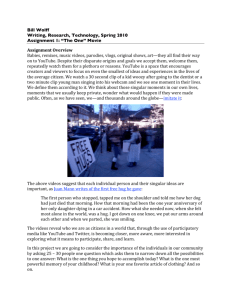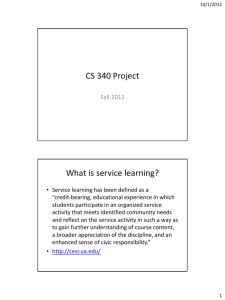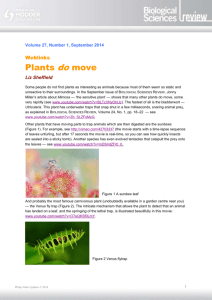ESL students create mini YouTube video lessons
advertisement

“ESL students create mini YouTube video lessons” TESOL – March 28, 2009 Tom Rohrbach Spring International Language Center Denver and Littleton, Colorado tom@spring.edu OVERVIEW – You may be wondering… What do you do on YouTube? Why? How do you do it? How can we do it? (Do we want to?) Discussion … Questions and Answers Watch a final video (if time allows) I. Our websites, and sample videos Spring WebRoom – www.spring.edu/webroom WebRoom VIDEO LESSONS page – www.spring.edu/webroom/video.html Spring’s YouTube Channel – www.youtube.com/springinternational Videos – “Make Up” and “The FBI” “Tacoman” – if time allows at the end II. A. What do I teach with videos? Classes – ‘Vocabulary-Video’, ‘Idioms-Video’, ‘Verbs-Video’ (all kinds of grammar included) Students learn phrasal verbs, idioms, grammar points. What else could you teach this way?! Students practice their English – vocabulary, conversation/discussion, creativity, writing skills, teamwork, spelling, grammar, pronunciation and intonation, acting, word-processing, etc. Great book: A Year in the Life of an ESL Student II. B. Why do I teach with videos? It’s FUN for the teacher AND the students, with lots of built-in motivation and challenge for students, and real-world rewards … when family, friends, classmates, and strangers the world over watch your videos on the Internet. We (my school and yours) can create an everexpanding library of online video lessons for ESL students: linking to each other’s YouTube sites, OR building a ‘mega-site’ together, if you’re interested. III. WHO ? Our Spring classes so far have been with intermediate and high intermediate adult Intensive English students. You could do the same with high school or junior high students, or…? Our classes are 4 hours a week, for nine weeks. Who watches? We’ve had thousands of ‘views’ on our Spring YouTube channel. Classes or individuals at your school can use the videos (you can also create quizzes for them). Students from all over the world can watch, subscribe, study and learn from your online site. Cool! IV. HARDWARE and SOFTWARE HARDWARE WE USE … Camcorder: We use a high-quality Sony HDR-SR1 digital camcorder, with a hard drive (much easier than DVD- or cassette-based cameras). $600 - $1,500 Microphone: An external mic is usually better than the built-in one, so you can record from a distance and get more control of sound. A computer mic works well. Video Capture Hardware: You can transfer direct from camera to computer with a USB cable, but sometimes ‘vch’ gives you more control. IV. HARDWARE and SOFTWARE (continued) SOFTWARE WE USE … Microsoft Windows XP Microsoft Movie Maker (free, included as part of Win XP) YouTube (www.youtube.com) - Go to main page, sign up with a name for your school or program, and begin creating your ‘channel’ OR, you can use an Apple Macintosh system with iMovie software and a firewire connection BOOKS SAMS Teach Yourself Digital Video with Windows XP in a Snap by Greg Perry. SAMS, 2004. ISBN 0-672-32569-1 (best resource for using Movie Maker) MAC: iMovie ‘09 and iDVD: The Missing Manual (’08 edition also) IV. HARDWARE and SOFTWARE (continued) OPTIONAL SOFTWARE: Adobe Photoshop or Paint Shop Pro - if you want to make better title screen JPG pictures) ConvertXtoDVD 3 - great if you want to burn your movies to DVD PrimoPDF maker (free) or Adobe Acrobat - if you want to create PDF scripts like we do V. THE COURSE We teach a nine-week course, 4 hours per week. Teach the ‘subject matter’ for a few weeks. Students get into teams, start planning a skit/lesson week 3 or 4. Teams present their first draft idea for teacher and peer review. Teams finalize skits and ‘learn their lines’ (weeks 4, 5, 6) Teams plan productions, props, locations, etc. Shoot the videos, review the ‘rushes’, re-shoot as needed. Edit and create the movie, choose background music. Music – we use free tunes from www.partnersinrhyme.com Upload to YouTube and add to our Video Lessons page. Celebrate and give out Awards! VI. HOW TO DO IT FILMING Set up on location. Do sound and light check, with a TV. Students rehearse and do simple blocking. Camera person sets up best spots. Shoot. Watch. Shoot again. Shoot again as needed. (Tell them in Hollywood, actors need 20 ‘takes’ sometimes!) Teacher – watch again to check grammar, pronunciation, and such. It’s easy to miss while shooting! Keep a ‘Shooting Log’ sheet with title of video, names and email of actors, camera person, guests, etc. VI. HOW TO DO IT (continued) EDITING Upload (import or capture) raw video scenes to Movie Maker. Use Movie Maker to ‘split’ each scene exactly where you want to start and stop it. You can also merge scenes, fade in and out, etc. CREATE TITLES – You can use the built-in functions, but I prefer to use Microsoft Word to make precise screens in ‘Landscape’ mode, then print screen and crop it in a photo program. Save as JPG. Import your JPG titles. Drag items to the “Storyboard” at bottom of screen to make movie. Change to “Timeline” view to add music. SAVE often! VI. HOW TO DO IT (continued) FINISHING YOUR MOVIE Add ‘transitions’ as desired. Watch movie to double-check. Save – file will be something like “Check_Out.MSWMM”. Then, click “File”, “Save Movie File” and follow instructions. Now, your movie is done, saved in “.WMV” format. UPLOAD TO ‘YOUTUBE’ Log in to your school’s YouTube channel. Upload your new video. YouTube will convert the movie automatically to its format. VII. ADVICE, TROUBLESHOOTING 1ST - Have high expectations and demand quality from students from Day 1. 2nd - Remember Murphy’s Law! 3rd - Budget your time, then double it! 4th - Try to have hardware backups, if possible. 5th - Be a patient and supportive director with students. PROBLEMS you can expect: dead batteries … microphone trouble … cable and adapter trouble (I tripped over a cable, broke an audio adapter!) … uploading-to-computer glitches … uploading-to-YouTube glitches … can’t redo a video once it’s on YouTube (delete, do over) … VII. ADVICE (continued) ALWAYS SAVE EVERYTHING IN THE SAME FOLDER !!! Raw video footage Pictures, title screen JPGs Music files MSWMM Movie Maker projects Finished WMV movies “My Documents \ My Videos” is a good place to save VIII. WANT TO TRY IT ?! Try it at your school! Consider your first batch of videos as practice. Link your YouTube channel to Spring’s. Let’s start a trend! Keep in touch! tom@spring.edu



